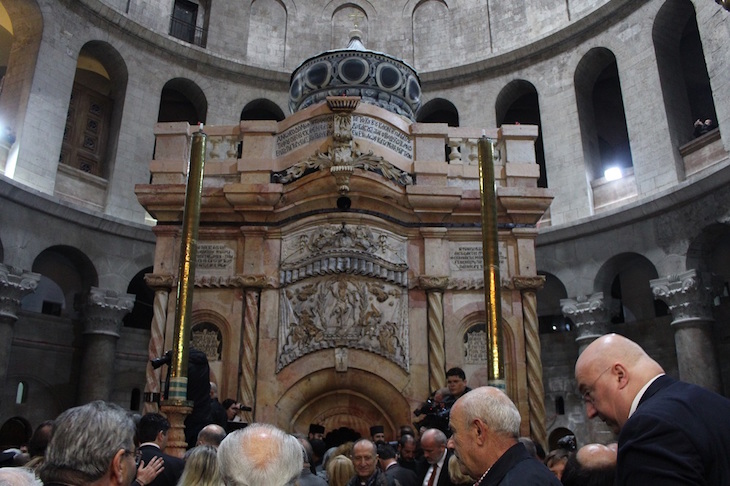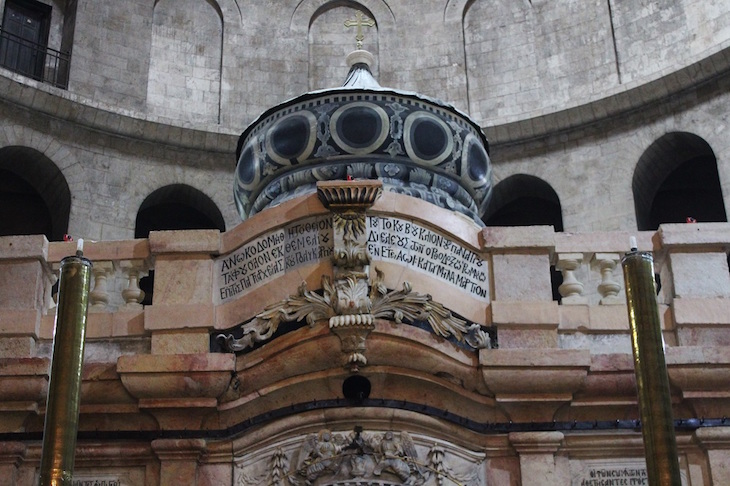Exactly one year after conservation work began on the holiest site in Christianity, church patriarchs came together in a ceremony on Wednesday morning to unveil the restored shrine, believed to house Jesus’s tomb in Jerusalem’s Church of the Holy Sepulchre.
As honoured guests surrounded the gleaming, rose-coloured marble of the Edicule of the Tomb, Orthodox Patriarch Theophilos III welcomed the crowd. ‘For the first time in over two centuries, the sacred Edicule has been restored for the veneration of the faithful,’ he said. ‘This restoration of the sacred Edicule is not only a gift to our Holy Land, but to the whole world.’
Prior to its restoration, the Edicule, constructed over the presumed site of Jesus’s burial and resurrection, was at risk of collapsing. Its marble cladding, last rebuilt in 1810 after a fire destroyed the shrine’s exterior, was quick to destabilise as a result of poor drainage, humidity and constant use.

Photo: the author
Since 1947, an incongruent iron cage-like structure, put in place by British Mandate authorities, supported the Edicule. Its marble walls were blackened by the build-up of soot from the church’s many candles and lanterns, and the wear and tear of centuries of pilgrimage were evident both inside and out.
Incredibly, the tomb remained open to pilgrims and tourists throughout the year-long, €3.7 million renovation. The conservation team from the National Technical University of Athens, headed by Antonia Moropoulou, worked day and night to assess the tomb’s structural decay, and carry out scientifically appropriate rehabilitation techniques.
This Easter, pilgrims will see the Edicule as it appeared 200 years ago. The 70-year old iron structure put in place by the British has disappeared. The marble cladding was removed, cleaned and reinforced with titanium supports, and the Edicule’s onion-style dome design was restored to its original blues and greys. In October 2016, the team uncovered the tomb itself, and confirmed the base marble slab dates back to the 4th century Constantinian period. And for the first time in history, the frescoes decorating the entryway’s Chapel of the Angel were cleaned and revealed. For Moropoulou and her team, the scientific and spiritual weight of the restoration project loomed large.
‘The preservation of values was a major and permanent challenge,’ Moropoulou said while describing the technical breadth of the restoration after the ceremony. ‘We are proud because we worked collectively and in open dialogue with Christian, technical and archaeological authorities, exercising in practice the values and traditions of the National Technical University of Athens. That means science with excellence, with integrity and with the spirit of freedom and creation.’

Photo: the author
The conservation signals a new era of cooperation among the six Christian denominations that function within the Church of the Holy Sepulchre, a 12th-century structure that was built over 4th-century remains. Rivalries between the sects date back centuries and have even resulted in physical altercations; since the 12th century, custodianship of the church’s keys have been entrusted to a neutral party – a Muslim family within the Old City.
Last year’s historic restoration agreement, headed by the Greek Orthodox Patriarchate, the Armenian Patriarchate, and the Roman Catholic Franciscan Order, followed 50 years of division between the different denominations as to how the restoration work should be carried out.
A team from the National Technical University of Athens will continue monitoring the humidity levels and inevitable dampness beneath the Edicule, which pose ongoing structural threats. After Moropoulou and her team turned the Edicule back over to the religious leaders, she stressed that their work will only be maintained by changing the attitudes of visitors to the holy tomb.
‘The overall sustainability of the rehabilitated Holy Edicule, your Beatitude, your Paternity, is at your hands,’ she said, addressing the patriarchs. ‘We need new pilgrims’ attitudes to the adoration of the Holy Edicule in order to sustain it, but we can’t go further. This is your decision in the culture developed among the pilgrims.’

Jesus’s tomb has been restored in Jerusalem
Photo: the author
Share
Exactly one year after conservation work began on the holiest site in Christianity, church patriarchs came together in a ceremony on Wednesday morning to unveil the restored shrine, believed to house Jesus’s tomb in Jerusalem’s Church of the Holy Sepulchre.
As honoured guests surrounded the gleaming, rose-coloured marble of the Edicule of the Tomb, Orthodox Patriarch Theophilos III welcomed the crowd. ‘For the first time in over two centuries, the sacred Edicule has been restored for the veneration of the faithful,’ he said. ‘This restoration of the sacred Edicule is not only a gift to our Holy Land, but to the whole world.’
Prior to its restoration, the Edicule, constructed over the presumed site of Jesus’s burial and resurrection, was at risk of collapsing. Its marble cladding, last rebuilt in 1810 after a fire destroyed the shrine’s exterior, was quick to destabilise as a result of poor drainage, humidity and constant use.
Photo: the author
Since 1947, an incongruent iron cage-like structure, put in place by British Mandate authorities, supported the Edicule. Its marble walls were blackened by the build-up of soot from the church’s many candles and lanterns, and the wear and tear of centuries of pilgrimage were evident both inside and out.
Incredibly, the tomb remained open to pilgrims and tourists throughout the year-long, €3.7 million renovation. The conservation team from the National Technical University of Athens, headed by Antonia Moropoulou, worked day and night to assess the tomb’s structural decay, and carry out scientifically appropriate rehabilitation techniques.
This Easter, pilgrims will see the Edicule as it appeared 200 years ago. The 70-year old iron structure put in place by the British has disappeared. The marble cladding was removed, cleaned and reinforced with titanium supports, and the Edicule’s onion-style dome design was restored to its original blues and greys. In October 2016, the team uncovered the tomb itself, and confirmed the base marble slab dates back to the 4th century Constantinian period. And for the first time in history, the frescoes decorating the entryway’s Chapel of the Angel were cleaned and revealed. For Moropoulou and her team, the scientific and spiritual weight of the restoration project loomed large.
‘The preservation of values was a major and permanent challenge,’ Moropoulou said while describing the technical breadth of the restoration after the ceremony. ‘We are proud because we worked collectively and in open dialogue with Christian, technical and archaeological authorities, exercising in practice the values and traditions of the National Technical University of Athens. That means science with excellence, with integrity and with the spirit of freedom and creation.’
Photo: the author
The conservation signals a new era of cooperation among the six Christian denominations that function within the Church of the Holy Sepulchre, a 12th-century structure that was built over 4th-century remains. Rivalries between the sects date back centuries and have even resulted in physical altercations; since the 12th century, custodianship of the church’s keys have been entrusted to a neutral party – a Muslim family within the Old City.
Last year’s historic restoration agreement, headed by the Greek Orthodox Patriarchate, the Armenian Patriarchate, and the Roman Catholic Franciscan Order, followed 50 years of division between the different denominations as to how the restoration work should be carried out.
A team from the National Technical University of Athens will continue monitoring the humidity levels and inevitable dampness beneath the Edicule, which pose ongoing structural threats. After Moropoulou and her team turned the Edicule back over to the religious leaders, she stressed that their work will only be maintained by changing the attitudes of visitors to the holy tomb.
‘The overall sustainability of the rehabilitated Holy Edicule, your Beatitude, your Paternity, is at your hands,’ she said, addressing the patriarchs. ‘We need new pilgrims’ attitudes to the adoration of the Holy Edicule in order to sustain it, but we can’t go further. This is your decision in the culture developed among the pilgrims.’
Unlimited access from just $16 every 3 months
Subscribe to get unlimited and exclusive access to the top art stories, interviews and exhibition reviews.
Share
Recommended for you
One photographer’s spiritual struggle in Jerusalem
In 1853 Auguste Salzmann went to Jerusalem to photograph religious sites. The results, on show at the Metropolitan Museum, are an insight into his own faith
Medieval Jerusalem comes to life in this mesmerising show
Expansive, near encyclopaedic within its limits, and very beautiful, this exhibition at the Metropolitan Museum is not to be missed
Banksy’s new art hotel offers rooms with a view
Is the street artist’s hotel in Palestine a tourist-led gimmick or a strong political statement?